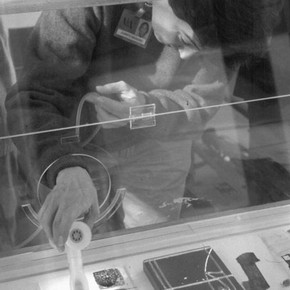Conservation Journal
January 1999 Issue 30
Consolidation of Painted Surfaces. A Workshop led by Sandra Grantham, 11th September 1998
The practical workshop, organised by members of the Communications Group, gave Sandra Grantham a forum in which to explain and demonstrate the application of a misted consolidation system developed during research for her PhD thesis. The successful consolidation of friable materials presents a constant challenge to every conservation discipline. Therefore, it was no surprise that the workshop created widespread interest .
Although its ten places soon filled up, there was room on the day for a group of 'non-participating' observers. In order to benefit fully from the workshop, it was necessary for the participants to prepare themselves in advance. The organisers provided relevant literature in the form of articles and product information and each discipline prepared facsimile samples and brought aqueous consolidants to experiment with.
Study of the articles provided gave the participants a knowledge of previous consolidation application methods. Sandra was therefore able to focus directly on her research into the consolidation of powdery and flaking paint on Japanese screens. She briefly explained her criteria for choosing a consolidant and how the technique was developed. This was followed by a demonstration of the misted consolidant applied to degraded paint layers on humidified paper samples.
A small air pressure nebulizer ('Pariboy'TM) , used to administer antibiotics in solution to patients, was used to deliver a mist of a chosen consolidant solution to an object within a humidity chamber.From its hose attachment a very fine mist, with 65% of the moisture droplets below 5 microns in size, can be applied gradually to the object with the intention of causing less disturbance to loose particles than a brush or spray application and with little or no colour change. The use of the consolidant on an already humidified object is essential if minimum colour change is desired. The relative humidity was maintained at 69% RH in the chamber during the application of the consolidant.
Having seen this successful application, it was then our turn to experiment on our samples. These included unstable bound or unbound pigments on porous and non-porous substrates (such as pastels on paper, painted wood, vellum, silk, terracotta and glass, gilded surfaces and degraded velvet). Consolidants of different concentrations were tested including methyl cellulose and gelatine. The results, and success, of our tests varied considerably. Sandra guided us through our initial attempts suggesting modifications or alternative methods where appropriate. Some disciplines, notably the Textile Section, enjoyed greater success with the technique than others.
After the practical session we shared our initial findings and knowledge of different surfaces and conservation problems. The informality of the session lent itself to a welcome exchange of currently held views and ideas including a discussion into the use of overall versus localised consolidation methods. We were all able to benefit from sharing in a colleague's area of particular expertise and contribute to a valuable interchange of information between disciplines and the RCA/V&A Conservation Course. Small group workshops provide valuable training in the development of practical skills and this session was a thought provoking, informative and enjoyable learning opportunity.
January 1999 Issue 30
- Editorial - Change, Access and Permanence
- Consolidation of Painted Surfaces. A Workshop led by Sandra Grantham, 11th September 1998
- The Novels of Charles Dickens; Bound to Last? The Structural Evolution of a Manuscript's Bindings
- Non-Destructive Pigment Analysis Using Raman Microscopy
- An investigation into the archival properties of colour photocopies and inkjet prints: Summary of a project undertaken at Camberwell College of Art as part of a BA in Paper Conservation, Spring 1996
- 24th Annual Conference of Canadian Association for Conservation of Cultural Property in Whitehouse, Yukon, 27-29 May 1998
- Science Surgery
- RCA/V&A Conservation Course Abstracts
- Issue 30 Printer Friendly Version
